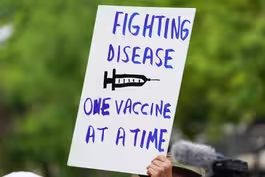
Scientists track humpback whale migration with help from AI
Clip: 6/28/2025 | 5m 10sVideo has Closed Captions
Scientists track humpback whale migration with an assist from AI technology
Humpback whales are some of the largest creatures on Earth and live in every one of the planet’s oceans. Their seasonal migrations are among the longest of any mammal, stretching thousands of miles. Now, scientists are using AI-powered facial recognition technology to track the whales on their journeys, offering new insights into their habits and health. John Yang reports.
Problems playing video? | Closed Captioning Feedback
Problems playing video? | Closed Captioning Feedback
Major corporate funding for the PBS News Hour is provided by BDO, BNSF, Consumer Cellular, American Cruise Lines, and Raymond James. Funding for the PBS NewsHour Weekend is provided by...

Scientists track humpback whale migration with help from AI
Clip: 6/28/2025 | 5m 10sVideo has Closed Captions
Humpback whales are some of the largest creatures on Earth and live in every one of the planet’s oceans. Their seasonal migrations are among the longest of any mammal, stretching thousands of miles. Now, scientists are using AI-powered facial recognition technology to track the whales on their journeys, offering new insights into their habits and health. John Yang reports.
Problems playing video? | Closed Captioning Feedback
How to Watch PBS News Hour
PBS News Hour is available to stream on pbs.org and the free PBS App, available on iPhone, Apple TV, Android TV, Android smartphones, Amazon Fire TV, Amazon Fire Tablet, Roku, Samsung Smart TV, and Vizio.
Providing Support for PBS.org
Learn Moreabout PBS online sponsorshipJOHN YANG: Humpback whales are some of the largest creatures on Earth and live in every one of the planet's oceans.
Their seasonal migrations are among the longest of any mammals, stretching thousands of miles as they travel between tropical breeding grounds and colder feeding grounds.
Now scientists are using AI powered facial recognition technology to track them on their journeys, offering new insights into their habits and their health.
JOHN YANG (voice-over): Even though adult humpback whales weigh as much as 40 tons and measure up to 60 feet long, that's longer than a school bus.
They can be dwarfed by the vast open waters of the oceans.
For decades, scientists tracked them by comparing photographs of their distinctive tails.
Marine biologist Ted Cheeseman.
TED CHEESEMAN, Co-founder, Happywhale.com: Much like a face, shows recognition features.
Right.
The size of my nose, the size of my chin, all that sort of thing.
Underside of a humpback whale's tail has patterns and shapes and scars that make them individually recognizable.
JOHN YANG (voice-over): Sifting through the thousands of photographs from a month long research voyage could take up to a year.
So Cheeseman turned to image recognition technology to do the same thing.
In about two days, he built a website called Happywhale where photographs can be uploaded and analyzed.
To date, scientists and the general public have submitted more than 1 million photos, creating a global catalog of more than 100,000 individual whales.
Each new data point provides more insight into the whales movements.
TED CHEESEMAN: It's hard to grasp the scale of a whale or creature that can just casually swim from Alaska to Mexico or Hawaii every season just to find a mate and then swim back and not feed the entire time.
3, 4 months without eating at all.
That's pretty hard to grasp.
But this gets us a little closer to being able to see that.
JOHN YANG (voice-over): Researchers discovered that a whale first seen in 2013 off the coast of Colombia in South America was spotted nine years later on the other side of the globe, near Zanzibar off eastern Africa.
Tourists flock to the waters where whales congregate for a glimpse of these awesome creatures.
CECILIA RUIZ, Co-founder and Guide, Proyecto Cetaceo: Sometimes they're just like breathing and we're all like, you know, and they're just like.
And we're like oh my gosh.
JOHN YANG (voice-over): Cecilia Ruiz runs whale watching expeditions in Cabo San Lucas, Mexico.
CECILIA RUIZ: They are super important for our oceans and they're super important for just the planet health in general.
I feel like we are sometimes disconnected with nature, with living our regular lives.
JOHN YANG (voice-over): She uses Happywhale to tell her clients the stories of the whales they see.
CECILIA RUIZ: If you tell them, like, oh, this specific whale came here, had their baby, and then they saw them in Canada, and then you tell them these stories and I feel like people engage more with the whales and see them more as individuals other than just animal that is migrating.
JOHN YANG (voice-over): She calls it Facebook for whales.
CECILIA RUIZ: I get notifications still like, hey, the whale you saw on January, it's now here, you know?
JOHN YANG (voice-over): About a third of the images on Happywhale are contributed by the public.
Earlier this year, a tourist on a whale watching cruise in Hawaii uploaded a photograph of what turned out to be the world's oldest known humpback whale called Old Timer.
The male was first identified by a scientist in 1972, making him at least 53 years old.
Crowdsourcing whale tracking has been a boon for scientists like Ted Cheeseman.
TED CHEESEMAN: We're able to actually see, thanks to the public's involvement, quite a lot more resolution with the science.
JOHN YANG (voice-over): With it, they can monitor how whales are coping with the threats posed by warming seas, being struck by ships and entangled in long lines used by commercial fishermen.
Scientists use that information to model population growth and even estimate the survival rate of individual whales.
Commercial whaling decimated the humpback whale's population in the 19th and 20th centuries.
It's recovered thanks to conservation efforts, which can be supported by the data Happywhale generation.
And Cheeseman says the public awareness the website generates is a benefit in itself.
TED CHEESEMAN: We published a lot of research papers as a result of the data that's flowing through this, and I think that's really meaningful and worthwhile.
But I think the publicly engaging side of it, the fact that this brings us closer to a very impressive and rather magical and hard to understand element of the.
Of the natural world, is probably what I'm most proud of.
Europe’s top diplomat discusses EU’s relationship with Trump
Video has Closed Captions
Clip: 6/28/2025 | 5m 31s | Europe’s top diplomat discusses EU’s relationship with Trump and next steps for Iran (5m 31s)
Former top CDC vaccine expert on why she resigned in protest
Video has Closed Captions
Clip: 6/28/2025 | 5m 53s | Former top CDC vaccine expert on why she resigned in protest over firing of advisory panel (5m 53s)
How comedian Robin Tyler fought for LGBTQ+ rights with humor
Video has Closed Captions
Clip: 6/28/2025 | 4m 49s | How pioneering comedian Robin Tyler used humor to fight for LGBTQ+ rights (4m 49s)
News Wrap: GOP unveils Senate version of Trump’s big bill
Video has Closed Captions
Clip: 6/28/2025 | 2m 9s | News Wrap: Senate Republicans unveil their version of Trump’s big budget bill (2m 9s)
Providing Support for PBS.org
Learn Moreabout PBS online sponsorshipSupport for PBS provided by:
Major corporate funding for the PBS News Hour is provided by BDO, BNSF, Consumer Cellular, American Cruise Lines, and Raymond James. Funding for the PBS NewsHour Weekend is provided by...















